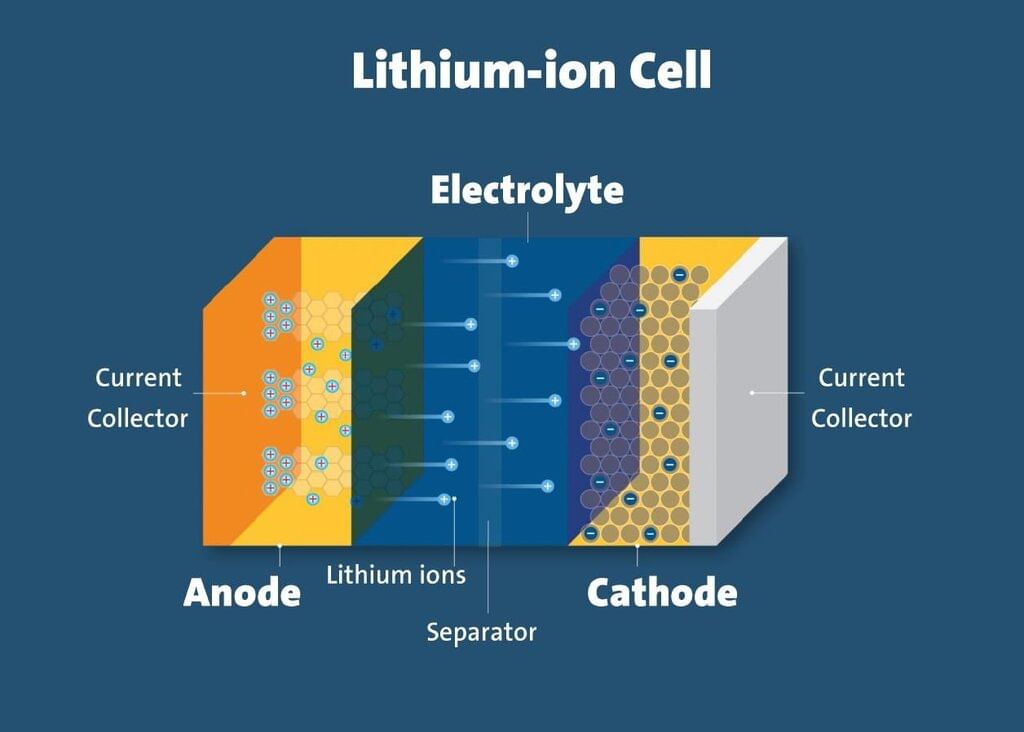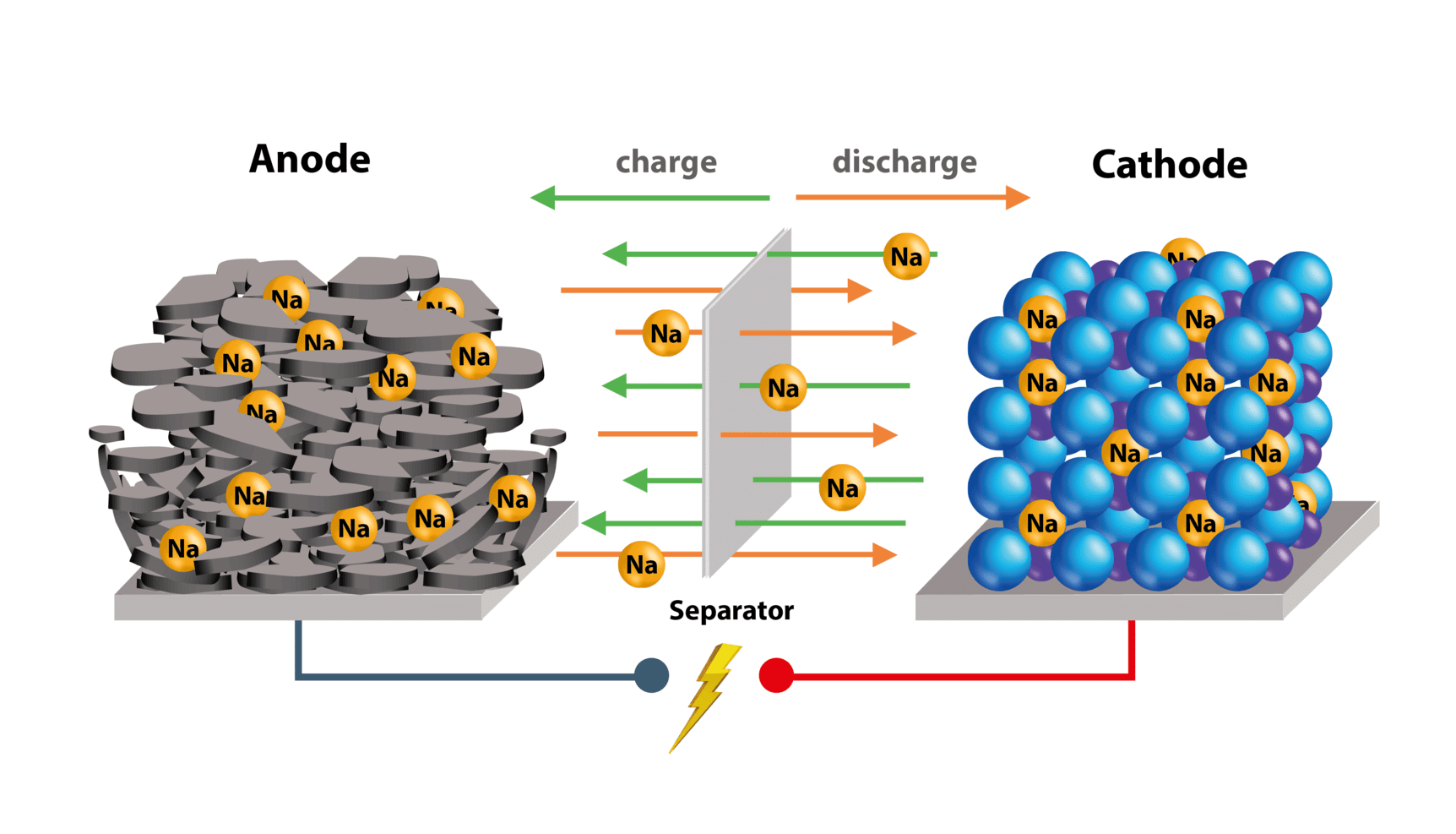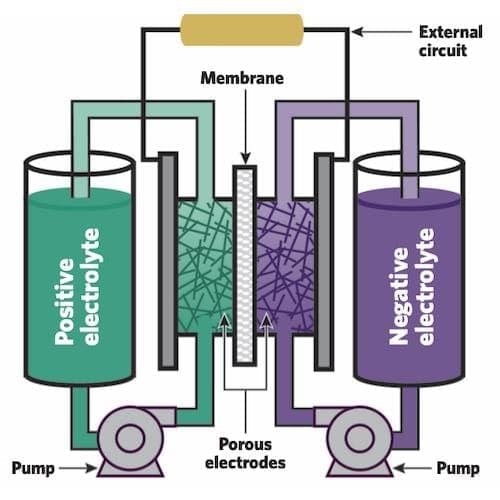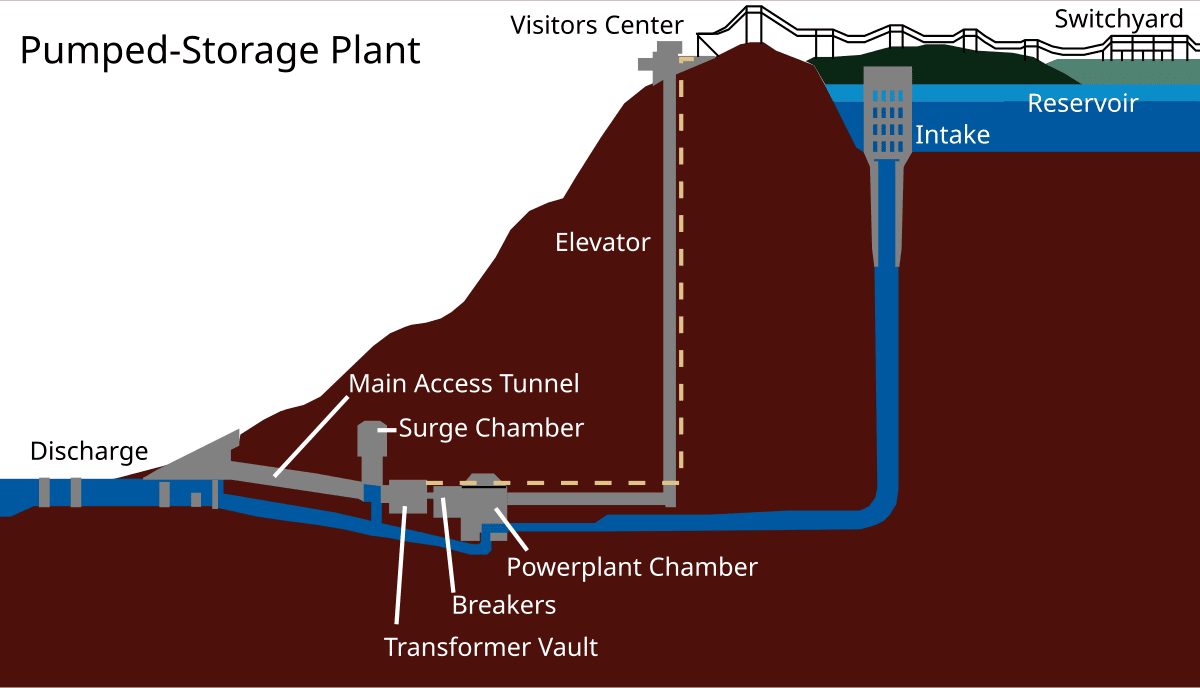Energy Storage Technologies – Lithium-ion, Sodium-ion, Flow Batteries, Pumped Hydro | Science & Technology for UPSC CSE PDF Download
| Table of contents |

|
| Introduction |

|
| Lithium-ion Batteries |

|
| Sodium-ion Batteries |

|
| Flow Batteries |

|
| Pumped Hydro Storage |

|
| India’s Role and Global Context |

|
| Challenges, Future Prospects, and Significance |

|
Introduction
Energy storage technologies store excess energy generated during peak production and release it during demand spikes, ensuring grid reliability and renewable integration. Lithium-ion batteries dominate due to their high efficiency and versatility, while sodium-ion batteries offer a cost-effective, sustainable alternative. Flow batteries provide long-duration storage for grid applications, and pumped hydro storage remains the most established large-scale solution. In India, these technologies support the National Solar Mission, Wind Mission, and Green Hydrogen Mission, aligning with the National Action Plan on Climate Change (NAPCC). Recent developments, such as the Production-Linked Incentive (PLI) scheme for Advanced Chemistry Cells (ACC) and India’s collaboration with the US under the iCET initiative, underscore their role in achieving Aatmanirbhar Bharat and global clean energy leadership. This topic is vital for UPSC, linking technology, policy, and environmental goals.
Lithium-ion Batteries

Technology
Principle: Stores energy via reversible electrochemical reactions between lithium ions, a cathode (e.g., lithium cobalt oxide), and an anode (e.g., graphite). Electrolytes facilitate ion movement.
Types: Lithium iron phosphate (LFP), nickel manganese cobalt (NMC), lithium titanate (LTO), varying in energy density and safety.
Specifications: Energy density ~150–250 Wh/kg; efficiency ~90–95%; cycle life ~2,000–5,000 cycles.
Applications
Electric Vehicles (EVs): Powers ~80% of India’s EVs (1.5 million units in 2025).
Grid Storage: Stabilizes renewable energy grids (e.g., 100 MW battery in Delhi, 2024).
Consumer Electronics: Smartphones, laptops, and portable devices.
Renewable Integration: Stores solar/wind energy for off-peak use.
Advantages
High Efficiency: 90–95% round-trip efficiency.
Compactness: High energy density suits mobile and urban applications.
Mature Technology: Widespread production and supply chains.
Fast Response: Ideal for frequency regulation in grids.
Challenges
Cost: ₹7–10 lakh/MWh; high due to lithium and cobalt imports.
Resource Scarcity: Lithium and cobalt are limited; India imports 70% of lithium.
Safety: Risk of thermal runaway and fires if mismanaged.
Recycling: Only 5% of batteries recycled in India (2025); environmental concerns from disposal.
India’s Initiatives
PLI Scheme for ACC: ₹18,100 crore allocated in 2021; 50 GWh capacity added by 2025 (e.g., Ola Electric, Reliance).
FAME India Phase II: ₹10,000 crore for EV battery adoption; extended to 2025.
Battery Swapping Policy (2022): Promotes EV infrastructure; 50 swapping stations operational in 2025.
Recycling: MNRE guidelines (2024) mandate 90% battery recycling by 2030.
Sodium-ion Batteries

Technology
Principle: Similar to lithium-ion, uses sodium ions with cathodes (e.g., sodium metal oxides) and anodes (e.g., hard carbon). Operates at ambient temperatures.
Specifications: Energy density ~100–150 Wh/kg; efficiency ~85–90%; cycle life ~3,000–7,000 cycles.
Applications
Grid Storage: Cost-effective for large-scale renewable integration.
EVs: Emerging for low-cost vehicles (e.g., two-wheelers in India).
Stationary Storage: Backup power for rural and industrial areas.
Advantages
Abundant Materials: Sodium widely available; no reliance on scarce lithium or cobalt.
Cost: ~30% cheaper than lithium-ion (₹5–7 lakh/MWh).
Safety: Lower risk of thermal runaway; stable in extreme conditions.
Sustainability: Uses eco-friendly materials, easier to recycle.
Challenges
Lower Energy Density: Less suitable for compact devices or high-performance EVs.
Early Stage: Limited commercial deployment; India’s first pilot launched in 2024.
Infrastructure: Requires new manufacturing facilities, lagging behind lithium-ion.
Performance: Slower charge/discharge rates than lithium-ion.
India’s Initiatives
R&D: BARC and IIT Madras lead sodium-ion development; pilot plant in Gujarat (2024).
PLI Scheme: Extended to sodium-ion in 2025; 10 GWh capacity planned by 2028.
Startups: Companies like Altmin and KPIT Technologies scaling sodium-ion for grid storage.
Flow Batteries

Technology
Principle: Stores energy in liquid electrolytes (e.g., vanadium, zinc-bromine) in external tanks, separated by a membrane. Energy is generated via ion exchange.
Specifications: Energy density ~20–70 Wh/kg; efficiency ~75–85%; cycle life ~10,000–20,000 cycles.
Applications
Grid Storage: Long-duration storage (6–12 hours) for renewable grids.
Microgrids: Powers remote areas and industrial hubs.
Peak Shaving: Reduces demand spikes in urban grids.
Advantages
Long Lifespan: Up to 20 years, ideal for grid applications.
Scalability: Energy capacity increased by adding larger tanks.
Safety: Non-flammable electrolytes reduce fire risks.
Recyclability: Electrolytes reusable, minimizing waste.
Challenges
Low Energy Density: Bulky systems, unsuitable for mobile applications.
High Cost: ₹15–20 lakh/MWh due to expensive materials (e.g., vanadium).
Complexity: Requires pumps and maintenance, increasing operational costs.
Limited Adoption: Only 1 GW globally (2025); nascent in India.
India’s Initiatives
Pilot Projects: 10 MW vanadium flow battery installed in Tamil Nadu (2024) for solar integration.
R&D: CSIR-CECRI develops low-cost zinc-bromine flow batteries; trials planned for 2026.
Budget 2025-26: ₹2,000 crore for flow battery R&D and grid storage pilots.
Pumped Hydro Storage

Technology
Principle: Stores energy by pumping water to a higher elevation during excess power availability, releasing it through turbines to generate electricity during demand.
Specifications: Efficiency ~70–85%; capacity up to 1,000 MW; lifespan ~50–100 years.
Applications
Grid Storage: Balances large-scale renewable energy (e.g., solar parks).
Peak Load Management: Supplies power during high-demand periods.
Renewable Integration: Stores wind/solar energy for 24/7 availability.
Advantages
Proven Technology: Accounts for 95% of global storage capacity (170 GW in 2025).
Long Lifespan: Decades-long operation with low maintenance.
High Capacity: Suitable for large-scale grid needs.
Cost-Effective: ₹2–3 lakh/MWh, cheaper than batteries for long-term storage.
Challenges
Geographical Constraints: Requires specific topography (elevation, water source).
Environmental Impact: Affects ecosystems; land acquisition delays projects.
High Upfront Costs: ₹5–10 crore/MW for construction.
Long Development Time: 5–10 years for project completion.
India’s Initiatives
Capacity: 4.7 GW operational (2025); 26 GW under construction (e.g., Tehri, Koyna).
Policy: MNRE’s 2023 guidelines prioritize pumped hydro for renewable integration.
Budget 2025-26: ₹5,000 crore for 10 GW new capacity by 2030.
Projects: Upper Indravati (600 MW, Odisha) and Pinnapuram (1,200 MW, Andhra Pradesh) under development.
India’s Role and Global Context
India’s Role
Renewable Integration: Storage supports 208 GW renewable capacity, targeting 500 GW by 2030.
PLI Scheme: ₹18,100 crore for ACC (lithium-ion, sodium-ion); 50 GWh capacity by 2025.
Aatmanirbhar Bharat: Domestic manufacturing of batteries (e.g., Tata, Reliance) reduces import reliance (70% for lithium-ion in 2024).
R&D Leadership: BARC, IITs, and CSIR drive sodium-ion and flow battery innovation.
Policy Support: National Energy Storage Mission (draft 2022) targets 50 GW storage by 2030.
Global Context
Market Growth: Energy storage market at USD 221 billion (2024), projected to USD 435 billion by 2030.
Key Players:
China: Leads with 30 GW battery storage; dominates lithium-ion supply (60% global share).
US: 10 GW battery storage; Tesla and Fluence lead in grid-scale systems.
EU: 5 GW flow batteries; Germany pushes sodium-ion for sustainability.
Australia: 2 GW pumped hydro; Snowy 2.0 (2,200 MW) under construction.
Trends (2025): Shift to sodium-ion for cost, flow batteries for long-duration storage, and hybrid systems (battery + pumped hydro).
Recent Developments
Budget 2025-26: ₹15,000 crore for storage, including ₹5,000 crore for pumped hydro, ₹2,000 crore for flow batteries, and ₹8,000 crore for ACC manufacturing.
International Ties: India-US iCET (2025) supports battery R&D; India-Australia collaboration for pumped hydro tech transfer.
Pilot Projects: 100 MW lithium-ion grid storage in Gujarat (2024); 10 MW sodium-ion pilot in Chennai (2025).
Recycling: MNRE’s 2024 guidelines mandate 90% battery recycling by 2030; 5 recycling plants operational.
Challenges, Future Prospects, and Significance
Challenges
Cost: Lithium-ion and flow batteries remain expensive; economies of scale needed.
Import Dependence: 70% lithium-ion components and 80% electrolysers imported, challenging self-reliance.
Environmental Impact: Lithium mining and pumped hydro projects disrupt ecosystems.
Infrastructure: Limited charging/swapping stations for EVs; grid upgrades needed for storage integration.
Public Perception: Safety concerns (e.g., battery fires) slow EV and storage adoption.
Future Prospects
Cost Reduction: Lithium-ion costs to drop to ₹5 lakh/MWh, sodium-ion to ₹3 lakh/MWh by 2030.
Domestic Manufacturing: 100 GWh battery capacity by 2030 via PLI; 10 GW flow battery capacity by 2035.
Pumped Hydro Expansion: 50 GW by 2040, supporting large-scale renewable integration.
Global Leadership: India to export sodium-ion batteries and storage tech to Global South by 2030.
Hybrid Systems: Battery + pumped hydro for grid stability; pilot projects planned for 2027.
Significance for India
Energy Security: Storage supports 500 GW renewable target, reducing fossil fuel imports (₹12 lakh crore in 2024).
Climate Goals: Enables 50% non-fossil fuel capacity by 2030; supports net-zero by 2070.
Economic Impact: Creates 5 lakh jobs; contributes to $1 trillion renewable economy by 2035.
Global Standing: Strengthens India’s role in ISA, G20, and UNFCCC through storage innovation.
Lithium-ion, sodium-ion, flow batteries, and pumped hydro storage are critical to India’s clean energy transition, enabling renewable energy integration and grid stability. India’s initiatives, backed by the 2025-26 budget and PLI schemes, aim to scale storage capacity and reduce import dependence. Global trends, like sodium-ion adoption and hybrid systems, guide India’s strategy. Addressing challenges like costs, infrastructure, and environmental impacts will ensure success.
|
90 videos|491 docs|209 tests
|
FAQs on Energy Storage Technologies – Lithium-ion, Sodium-ion, Flow Batteries, Pumped Hydro - Science & Technology for UPSC CSE
| 1. What are the primary advantages of lithium-ion batteries in energy storage applications? |  |
| 2. How do sodium-ion batteries differ from lithium-ion batteries? |  |
| 3. What are flow batteries, and what are their key benefits? |  |
| 4. What role does pumped hydro storage play in energy management? |  |
| 5. What challenges does India face in adopting advanced energy storage technologies? |  |















